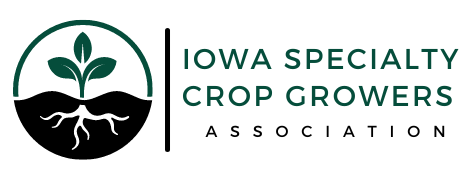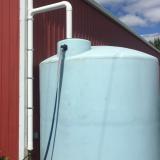Asparagus, rhubarb and horseradish are three perennial vegetables that, once planted, will come back from their roots year after year. When fully established in a favorable location, and when good cultural practices are followed, a crop can be harvested from these plants each year. Iowa State University Extension and Outreach horticulturists offer tips on suitable locations, good varieties and proper planting of asparagus, rhubarb and horseradish in Iowa.
What is a suitable planting site for perennial vegetables like asparagus, rhubarb or horseradish?
Carefully consider possible planting sites for perennial vegetables. Plantings are not moved from year to year and, when well-maintained in a favorable location, will be productive for many years. A location at the end of the vegetable garden that doesn’t interfere with annual garden tillage and other cultural practices is a good site.
Grow asparagus, rhubarb and horseradish in moist, well-drained soils. Rhubarb prefers highly organic soils, and horseradish is better grown in low-fertility soils to help control its rapid growth rate. Avoid poorly drained, wet sites. Heavy, clay soils can often be improved by incorporating organic matter, such as compost or well-rotted manure, into the upper 12 to 15 inches of soil. Raised beds are also a good planting option for sites with poorly drained soils. Raised beds not only help create a soil that is ideal for the vegetable, but also help contain the spreading nature of some of these perennial vegetables, especially horseradish.
Start with a weed free planting area. Weed control in the first few growing seasons is important to establishing hardy plants that will be productive year after year. Weeds can become a significant issue over time when not well-maintained. The planting site should receive at least six to eight hours of direct sun each day. Horseradish can tolerate part shade, but prefers full sun. Avoid shady sites near trees and shrubs.
What are some good asparagus varieties for Iowa?
Asparagus is dioecious, meaning that it produces separate male and female plants. Male asparagus plants live longer and are more productive than female plants. Excellent predominantly male asparagus cultivars include ‘Jersey Giant,’ ‘Jersey Knight,’ ‘Jersey King’ and ‘Jersey Supreme.’ Standard asparagus cultivars will have an equal number of male and female plants, and include cultivars such as ‘Mary Washington’ and ‘Martha Washington.’ ‘Purple Passion’ and ‘Sweet Purple’ are unique cultivars with deep burgundy or purple spears that turn green when cooked. One-year-old bare root asparagus crowns can be purchased at garden centers and mail-order nurseries.
What are the best rhubarb varieties for Iowa?
The cultivars ‘Canada Red,’ ‘Crimson Red,’ ‘McDonald’ and ‘Valentine’ have attractive red stalks and are good choices for Iowa gardens. ‘Victoria,’ a green-stalked cultivar, is another reliable performer. Rhubarb plants can be purchased at garden centers or from mail-order sources.
What horseradish varieties perform best in Iowa?
There are few cultivars available for horseradish. Instead, they are typically classified as one of two types: common and Bohemian. Common types have broad, crinkled leaves and are generally considered to be of superior quality. Bohemian types have narrower, smoother leaves and typically have better disease resistance. Most gardeners will find plants or root cuttings from garden centers or mail-order sources sold simply as “horseradish.”
What is the proper way to plant asparagus?
Early spring is the best time to plant asparagus in Iowa. Asparagus crowns should be planted in shallow trenches or furrows. The planting depth depends on the soil type. Asparagus crowns should be planted 8 to 10 inches deep in light, sandy soils, but only 6 to 8 inches deep in heavier soils. A small amount of compost or well-composted manure can be worked into the soil at the bottom of the trench before planting. Space crowns 12 to 18 inches apart in rows that are 4 to 5 feet apart. Then, spread the roots out in the trench with the buds pointing upward. After planting, completely fill in the trench with soil. Though a common practice in the past, it is not necessary to gradually fill in the furrow as the plants grow.
What is the proper way to plant rhubarb?
Spring is the best time to plant rhubarb in Iowa. Space individual plants 3 feet apart. Plants growing in containers should be planted at the same depth as they are currently growing in their pots. Bare-root plants should be planted with the buds 1 to 2 inches below the soil surface. Divisions or transplants from established plants is another common way to establish new rhubarb plants. Dig and divide large plants in early spring before growth starts, as soon as the soil can be worked easily. Dig deeply around the rhubarb clump and lift the entire plant out of the ground. Divide the clump into sections by cutting down through the crown between the buds. Each division should contain at least two or three buds and a large portion of the root system. Replant the divisions as soon as possible.
What is the proper way to plant horseradish?
Early spring is the best time to plant horseradish in Iowa. Horseradish spreads readily by offsets and root pieces left behind after harvest. Grow in an area where its spread can be contained. Loosen the soil down 8 to 12 inches and incorporate a small amount of compost or well-composted manure. Additional applications of fertilizer are not necessary for this vigorously growing plant. One to three plants spaced 12 to 18 inches apart is all that is necessary to produce enough horseradish for the typical home. Plants growing in containers are planted at the same depth as they are growing in the pot. Often, horseradish is sold as root cuttings. Typically, the top of the root is cut straight across and the bottom is cut at an angle. If you collect your own root cuttings, be sure to cut them in this same way so the cuttings can be oriented in the proper direction when planted. Dig a hole or trench and set root cuttings at a 45-degree angle with the slanted-cut side down, then backfill with soil. The top of the cutting (the end that is cut straight across) should be 1 to 2 inches below the soil surface when done.
When can I start harvesting newly planted perennial vegetables?
Perennial vegetables should be allowed to become well established after planting before any harvesting starts. Do not harvest asparagus or rhubarb for the first two years after planting. In the third and following years, asparagus can be harvested until early to mid-June in Iowa. Harvest rhubarb lightly in the third year, only collecting stalks for four weeks in spring. In the fourth and succeeding years, rhubarb stalks can be harvested for eight to 10 weeks. Horseradish is typically harvested in the late fall after the first frost of the season. Do not harvest horseradish roots the first year to allow plants to fully establish. Rather, begin harvesting horseradish annually the following fall.Category: Yard and GardenAbout the Authors:

